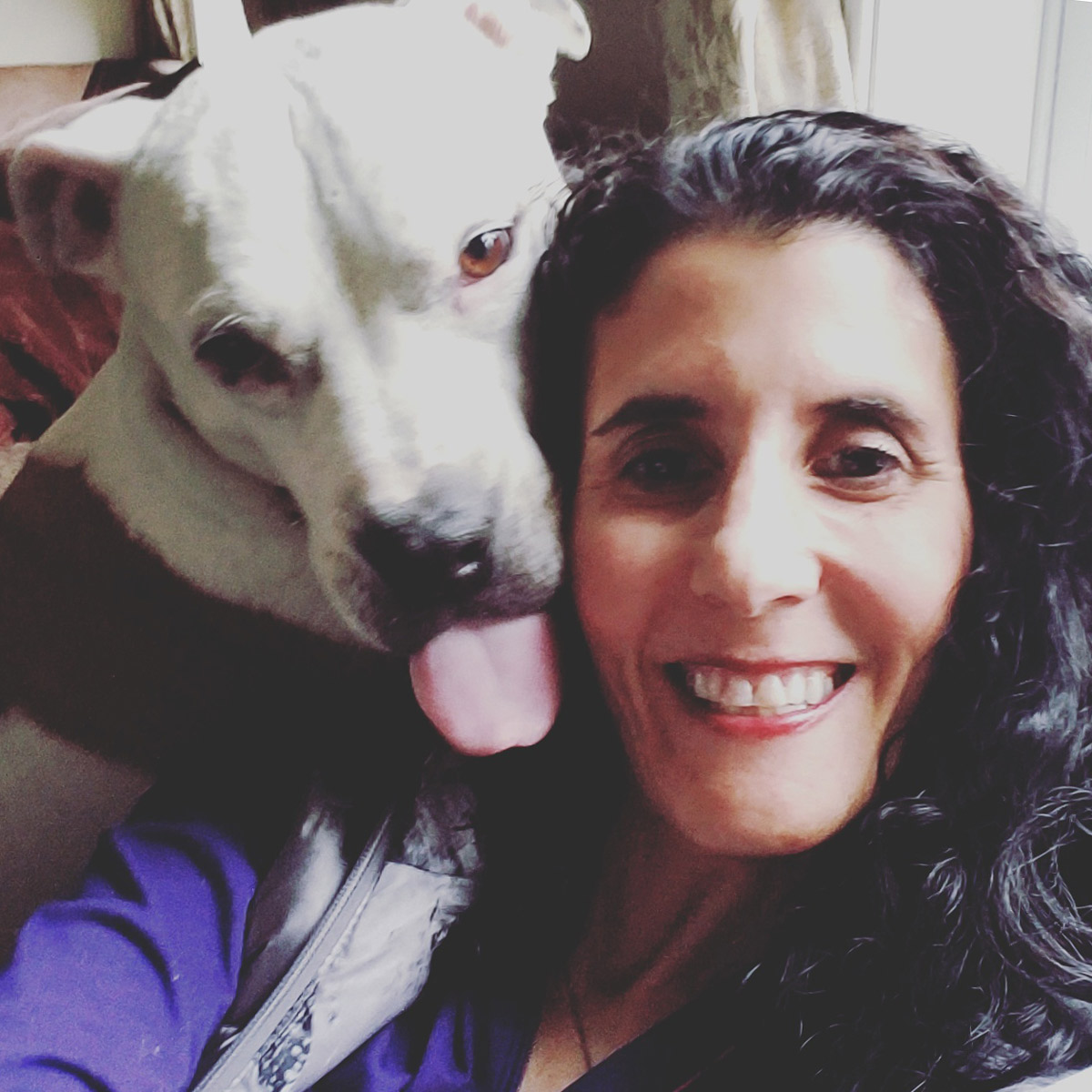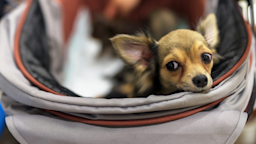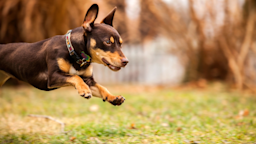Key takeaways:
You can help manage your dog’s anxiety, stress, or extra energy by making sure they get enough physical and mental exercise, among other approaches.
If your dog’s anxiety or hyperactivity don’t get better with home remedies, ask your vet about other options.
Certain active dog breeds are more prone to anxiety than others. Herding breeds and sporting dogs, for example, may need more activity to use up their energy.
Have you ever noticed that some dogs can’t sit still, while others are comfortable as couch potatoes? Some dogs have anxious energy, and that may have to do with their breed. Certain dog breeds are more likely to experience hyperactivity, stress, and anxiety.
There are many ways to address anxiety, stress, and hyperactivity in dogs. In some cases, it’s enough to make sure they’re getting adequate physical and mental stimulation. But there are other potential solutions.
Natural ways to calm an anxious or stressed dog
If you want to take a natural approach to calm down a hyper dog, there are techniques you can turn to. Here are five of them.
Search and compare options
1. Exercise
If your dog is anxious, there’s a good chance they’re not getting enough exercise. How much exercise a dog needs depends on their breed and age, so there’s no exact recommended amount. Try taking your dog on long walks, going hiking with them, or introducing them to dog sports.
And don’t forget about mental exercise. Try introducing your dog to puzzle toys or scent games to stimulate their mind. We’ll discuss more mental exercise ideas later in this article.
2. Massage
Massage can be a great way to help calm an anxious dog. Not only does it feel good and help them relax, but it also provides a sense of physical and emotional closeness between you and your dog. You may even find that massaging your dog also helps you feel less anxious.
3. Calming supplements
There are many types of calming supplements that work in different ways. You can find these supplements in various forms, including powders, gels, capsules, and treats. Most of them contain naturally calming active ingredients, such as melatonin or CBD.
4. Music
Music can calm an anxious dog just as it calms people. For one thing, music helps block out noises from the outside that may stress out your dog. If your dog gets anxious when you leave the house, try turning on classical music for them to listen to while you’re out.
5. Calming clothes
There are calming coats, shirts, and vests that apply pressure to a dog’s body to relax them. Sometimes, these items are described as “thundershirts.” They work like weighted blankets or swaddling for humans.
Look for signs. Take a close look at this list of dog anxiety symptoms to see if your dog’s behavior really is anxiety.
Be aware of motion sickness. It’s possible your dog seems anxious about car rides because they get motion sickness. Here’s how to help a queasy pup.
Help them adjust. If your dog makes a fuss every time you get ready to leave them behind, it could be separation anxiety. Learn how to help your pup.
Calming medications to help treat your dog’s anxiety
If you’ve tried these suggestions and your dog is still anxious or stressed, ask your vet what you can give your dog to calm them down. There are many anxiety medications that work for dogs in the same way they help people.
Your vet might recommend an antidepressant medication for your pup to reduce their anxiety. Antidepressants can be prescribed for dogs with severe anxiety. Examples of antidepressant medications your vet may recommend include:
Amitriptyline (Elavil)
Fluoxetine (Prozac)
Sertraline (Zoloft)
Paroxetine (Paxil)
Read more like this
Explore these related articles, suggested for readers like you.
Sometimes, veterinarians will prescribe sedatives for dogs who experience situational anxiety. This could be anxiety related to thunderstorms, fireworks, or a trip to the vet. Common medications a vet might suggest include Xanax (alprazolam) or gabapentin.
Common causes of anxiety in dogs
There are many causes of anxiety in dogs. Some of the more common reasons include:
Cognitive dysfunction syndrome (CDS)
Illness
Lack of exercise
Lack of socialization as puppies
Loud sounds, such as thunder or fireworks
Resource guarding
Territory guarding
How can you calm your dog down if they’re really hyperactive?
As any pet parent with a high-energy pup knows, active dogs need lots of exercise. Walking, jogging, or playing with an active pup is a great place to start. But you may need to use additional strategies, such as mental stimulation, to help calm your hyperactive dog.
Here are a few ways to put your dog to work and give them some serious mental exercise.
Turn mealtime into a job
Rather than feeding your dog from a bowl, place their food in a treat pouch or a bag that you carry in your pocket. Spend 20 minutes a day practicing training commands. Reinforce their positive behavior with food.
As your pup masters their training, introduce new commands and tricks. This is an exciting way to keep your dog mentally active, and it strengthens the bond between the two of you.
Train your dog to work for everything they need
Once you’ve ditched the dinner bowl, you can train your dog to work for more than just their food. Require something from your pup every time they want something. Maybe you teach them to sit by the open front door and wait for your command before going outside, for example. This is an easy way to give your dog a job.
Practice activities that involve nose work
A dog’s nose is thousands of times more sensitive than a human’s nose. This means the part of your dog’s brain that analyzes smells is much larger than that part is in the human brain. Scent-smelling exercises give them a lot of mental and physical stimulation.
Put your dog’s nose to work with a game of “sniff it out.” Hide pieces of kibble or dog treats around the house, and encourage your dog to find them by their smell. These activities engage both their mind and body in a fun way.
Make mealtime a puzzle
What do animals in the wild do to keep busy, fit, and healthy? They search for food. Giving your four-legged companion the opportunity to hunt for food gives them a job and engages them mentally and physically.
Puzzle feeders, treat dispensers, and other toys require dogs to figure out how to get their treat or food.
Start with easier puzzles so your dog doesn’t become frustrated. You want to make these games positive experiences for your pooch.
Consider canine sports
Active dogs often excel at sports. Basic classes for nearly every dog sport are widely available. Perhaps your pooch could channel their energy into one of the following:
Diving into water to retrieve toys, or dock diving
Flyball, which involves racing through hurdles to launch and then catch a ball
Disc dog, which involves chasing a flying disc
Search online to find canine sport classes in your area, or ask your veterinarian for recommendations.
Signs of anxiety in dogs
General symptoms of anxiety in dogs may include:
Destroying items they shouldn’t
Scratching at windows or doors
Showing signs of depression, such as changes in appetite or energy levels, or hiding
Barking constantly or whining
Drooling and panting
Pacing
Doing repetitive behaviors, such as licking or chewing
Being restless
Discuss any behaviors that could be symptoms of anxiety or a medical issue with your veterinarian. It might be helpful to have your dog evaluated for an anxiety disorder, which can be treated with behavioral interventions and medication.
Are some dog breeds more hyperactive or anxious than others?
Some dog breeds have a lot of energy. They may be more likely to show signs of anxiety. Other dogs, which are bred for specific jobs, may become anxious or hyperactive if they don’t get enough exercise or mental stimulation. Bear in mind that breed is only one indicator, and it really comes down to the individual dog.
Below are some of the most active dog breeds by group.
Herding breeds
Herding dogs are energetic by nature. These breeds instinctively seek to herd people and other animals. Some dogs in this category are Australian shepherds, collies, sheepdogs, and heelers.
Sighthounds
Also known as gazehounds, these dogs are bred to hunt and chase prey. Because they don’t rely on scent like other hound breeds, these dogs use speed and agility to keep up with their targets. They are high-speed, short-distance runners who may not respond to humans when chasing prey. Therefore, they can be tough to train. Greyhounds, wolfhounds, and whippets are in this group.
Sporting dogs
Sporting breeds tend to be intelligent and alert companions. These dogs were bred to work with hunters, and they naturally love outdoor field activities. Among the best-known sporting breeds are spaniels, pointers, retrievers, and setters.
Frequently asked questions
Research suggests that foods rich in antioxidants, such as apples and berries, may help relieve anxiety in dogs. Foods that contain tryptophan (turkey) and melatonin (salmon) may also help. Talk to your veterinarian before introducing new foods to your dog.
Turn on Bach or Beethoven. Classical music seems to have a calming effect on dogs. If your pup is afraid of fireworks, white noise may alleviate their stress.
Your dog may be anxious, stressed, or hyperactive for a number of reasons, including the characteristics of their breed and potential medical conditions. If your dog is highly energetic or seems to be experiencing anxiety, make sure they’re getting all their physical exercise needs met. Keep in mind that mental exercise can be just as important.
Look into harnessing your dog’s energy by involving them in nose work, agility training, or other canine sports. If no amount of physical or mental activity seems to calm your anxious dog, have them checked out by your veterinarian. They can rule out underlying medical issues. Your vet may also recommend an antianxiety medication, such as amitriptyline (Elavil), fluoxetine (Prozac), or sertraline (Zoloft).
Benadryl can make your dog drowsy, and that might help with their anxiety. But Benadryl is not an anxiety medication for dogs. It’s often used for other things, such as hives or motion sickness. Other medications, including amitriptyline (Elavil) and fluoxetine (Prozac), may be more effective.
Research suggests that foods rich in antioxidants, such as apples and berries, may help relieve anxiety in dogs. Foods that contain tryptophan (turkey) and melatonin (salmon) may also help. Talk to your veterinarian before introducing new foods to your dog.
Turn on Bach or Beethoven. Classical music seems to have a calming effect on dogs. If your pup is afraid of fireworks, white noise may alleviate their stress.
Your dog may be anxious, stressed, or hyperactive for a number of reasons, including the characteristics of their breed and potential medical conditions. If your dog is highly energetic or seems to be experiencing anxiety, make sure they’re getting all their physical exercise needs met. Keep in mind that mental exercise can be just as important.
Look into harnessing your dog’s energy by involving them in nose work, agility training, or other canine sports. If no amount of physical or mental activity seems to calm your anxious dog, have them checked out by your veterinarian. They can rule out underlying medical issues. Your vet may also recommend an antianxiety medication, such as amitriptyline (Elavil), fluoxetine (Prozac), or sertraline (Zoloft).
The bottom line
Your dog may be anxious, stressed, or hyperactive for a number of reasons, including the characteristics of their breed and potential medical conditions. If your dog is highly energetic or seems to be experiencing anxiety, make sure they’re getting all their physical exercise needs met. Keep in mind that mental exercise can be just as important.
Look into harnessing your dog’s energy by involving them in nose work, agility training, or other canine sports. If no amount of physical or mental activity seems to calm your anxious dog, have them checked out by your veterinarian. They can rule out underlying medical issues. Your vet may also recommend an antianxiety medication, such as amitriptyline (Elavil), fluoxetine (Prozac), or sertraline (Zoloft).

Why trust our experts?



References
Brooks, W. (2023). Diphenhydramine (Benadryl, Vetadryl, Banophen, Diphenhist). Veterinary Partner.
Calder, C. (2021). Behavior supplements in dogs and cats. Veterinary Partner.
Cornell University College of Veterinary Medicine. (n.d.). Anxious behavior: How to help your dog cope with unsettling situations.
Corti, L. (2014). Massage therapy for dogs and cats. Topics in Companion Animal Medicine.
Cummings School of Veterinary Medicine at Tufts University. (2023). Anxiety in dogs.
Dunbar, I. (n.d.). Hyper dog. Hyper Dog Behavior Blueprint.
Duranton, C., et al. (2019). Let me sniff! Nosework induces positive judgment bias in pet dogs. Applied Animal Behaviour Science.
Fan, Z., et al. (2023). Dietary strategies for relieving stress in pet dogs and cats. Antioxidants.
Fish, R. E., et al. (2017). Effect of wearing a telemetry jacket on behavioral and physiologic parameters of dogs in the open‑field test. Journal of the American Association for Laboratory Animal Science.
Hunt, R. L., et al. (2022). Effects of environmental enrichment on dog behaviour: Pilot study. Animals.
Judd, B. (2022). CBD use in dogs: An update. Veterinary Partner.
Landsberg, G. M., et al. (2025). Behavioral problems of dogs. Merck Veterinary Manual.
Li, W.-L., et al. (2023). Multiple origins and genomic basis of complex traits in sighthounds. Molecular Biology and Evolution.
Lindig, A. M., et al. (2020). Musical dogs: A review of the influence of auditory enrichment on canine health and behavior. Animals.
North American Flyball Association. (n.d.). What is flyball?
Ogata, N. (2015). Psychopharmacology. World Small Animal Veterinary Association World Congress Proceedings, 2015.
Ridgway, M. (2021). Herding dogs. Veterinary Clinics of North America: Small Animal Practice.
Tiira, K. (2015). Early life experiences and exercise associate with canine anxieties. PLoS One.
United States Dog Agility Association. (n.d.). Benefits of dog agility.
University of Massachusetts Amherst. (n.d.). Sporting group study guide.
Virginia-Maryland College of Veterinary Medicine. (2023). ‘5 tips for successful dog training.’
















